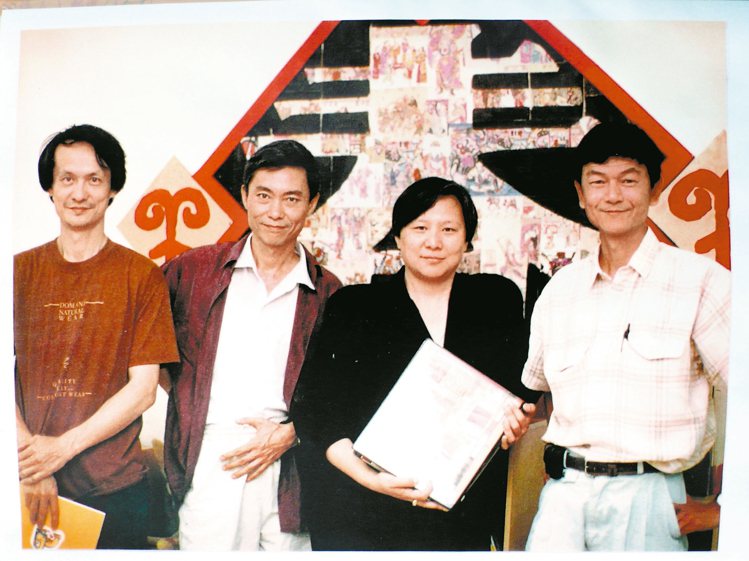2016-08-19 10:41 聯合報 林懷民
台灣無法自外於全球性趨勢,但能不能不再指責他人,朝野齊心找出台灣自己可以解決的問題,鍥而不捨,努力改善,來獲取翻轉,生存的基點?……
1974年,瑪莎.葛蘭姆首次率團來台演出。在歡迎酒會裡,她忽然表示要訪問雲門排練場。我說,地方很小。舞團經理連忙勸阻:「瑪莎,走遍全世界,妳從未做過這樣的事。天氣熱,不去吧!」老太太笑瞇瞇的說:「我要去拜訪林先生的排練場。」
雲門未滿周歲,祖師奶奶蒞臨,如何是好?無計可施,我做了只有少不經事的蠢蛋才會做的決定:在葛蘭姆面前,教一堂葛蘭姆技術課,再跳兩個小品。到了那天,我們打掃乾淨,準備泡茶待客,我忽然想起應該有人陪伴貴賓,匆忙下樓到麵店借電話,跟相識不久的Linda求救。
葛蘭姆前腳進門,Linda滿身大汗趕到,端莊得體地向大師致意,陪坐聊天,讓那天的活動順利進行。後來幾天,葛蘭姆總問我,那位聰慧美麗的吳小姐今天怎麼沒來。
相交四十多年,只要我求救,Linda總是二話不說,立刻拔刀相助。大家叫她俠女。大家叫她Linda。有些人叫她吳小姐,許多人不知她叫美雲,是長年在孫中山先生身旁工作,歷任上海市長,廣東省政府主席,革命元老吳鐵城的長孫女。因為祖父的感召,Linda念外交、軍事,立志帶兵衛國。回到台灣,無仗可打,走入文化界。
有一回,Linda給我看她剛回國那兩年的照片。合身旗袍襯出盈盈細腰,清麗素容,雙眼放光,是英氣而又溫柔的美女。她覺得酬酢應對的社交生活很無聊,脫掉旗袍,創辦ECHO,文化報國。
國際對台灣了解甚少,以為台灣就是Thailand,ECHO以英文向世界介紹傳統文化,介紹台灣。Linda對外徵才,找到藝專美術系畢業的黃永松和姚孟嘉合作。Linda公寓的客廳成為辦公室,浴室兼作沖洗照片的暗房,三人動手就編起雜誌。那是1970年,美雲二十六歲,永松二十七,孟嘉二十四。
紐約出生,台北美國學校,留學英美,Linda是「洋人」,英文編寫游刃有餘,傳統文化她從頭學起,請了家教補習中文,不怕鬧笑話的勤奮學習。俞大綱先生為我們講課,美雲凡事問。例如,講李義山,她會問:唐代是西元幾年?換算清楚後,「哦哦,是中古時代?那我們比歐洲人厲害太多了。」
認識文化,Linda全身投入。我們認為理所當然的事,她一定要自己弄明白。有一回到漢聲辦公室,竟然看到粗布唐裝的總編輯吳美雲女士坐在桌前有板有眼編草鞋。
Linda往生後,張照堂找出YouTube裡,一部叫作
Taoism:A Question of Balance的紀錄片,放到臉書上。影片敘述七◯年代,漢聲鐵三角帶著BBC記者到鄉村探索道家對台灣民間生活的影響。Linda流水的英文,漢聲諸君青春漾然的形象,純樸尋道的身姿令人感動,感慨!

吳美雲。 林懷民/圖片提供
支撐漢聲浪漫事業的是Linda的務實。ECHO出版前,她先找到華航的支持,第一期印兩萬冊,放到乘客座前的袋子。七◯年代,ECHO發行近三十個國家,為台灣發聲。1978年中文漢聲雜誌問世,法國歸來的奚淞正式加入團隊,漢聲四俠全員到齊,摩頂放踵,用才情與用心,一再為台灣出版業作出突破性的示範,影響三個世代的讀者,因而拓展了整個社會的視野和作為。
有那麼幾年,漢聲甄選編輯,報名者數百,要借用國小校舍舉辦。選聘二十人,一兩年後,如能留下四、五個勝任的編輯就算成果驚人。簡單的講,漢聲是「龜毛學校」。每個題材都是慢工出細活。雜誌社敦聘學者長年顧問,隨時出門請教專家,然後進行田野調查。大甲媽祖八天七夜的遶境活動,漢聲諸君實地走了三年,才變成鉛字。要講中國結,姚孟嘉學了三年,成為名副其實的專家,才開始思考如何呈現。為了介紹拳術,徐紀老師進漢聲,全體員工跟著學。漢聲是永遠飢渴的動物,總覺得吃不飽,消化反芻,整理到自在才肯吐給讀者。
那是台灣追尋島嶼身世的年代。往南部跑,成為台北知識分子和文藝青年的風尚。漢聲總是走在前頭。台灣移民史,台灣老地圖,漳州人,泉州人,客家人,阿里山鄒族馬雅茲比祭典都是雜誌的專題。採訪東港燒王船,漢聲在南鯤鯓發現洪通,報導之後這位素人畫家成為全國性的名人。朱銘在歷史博物館舉辦首度個展,漢聲邀請俞大綱先生專文推介,朱銘個展延期再三,長達一年。
孟嘉,永松出門,身上掛住大小攝影機,有如特種兵出任務。漢聲圖像千百選一,文字也重寫再三,要證據,講邏輯,還要精簡可讀,奚淞改完,總編輯Linda還要審,文章要讓中文早已流暢的「洋人」讀得快樂。主掌美編的永松摒棄一般的銅板紙,選了工業用紙印刷,從傳統美學出發,版面設計大膽,無洋味,也避開和風的陷阱。漢聲是手工業,總其成的孟嘉帶著年輕編輯慢工出細活,一項主題往往手繪三、四種版面草圖,斟酌再三。在1992年啟用電腦設計之前,漢聲用電腦打字完稿,一條條的紙片手工細貼,改字就得用美工刀挖補。進廠印刷,美工部門跟著進廠熬夜,盯圖校稿,講究用色深淺。有人說,漢聲即使倒立著看,仍然理路清明,找不出毛病。
漢聲雜誌主要是以現代觀點介紹民間傳統,但是打開第十期的「古蹟之旅」,讀者驚叫。一輛怪手巨獸般的盤踞大幅拉頁圖像的前景,半毀的板橋林家五落大厝塵沙飛揚。台北縣府的顧問公司評估荒廢多年的花園宅第是「中國建築的末流,其假山尤其可笑」,倡議鏟平,改建公園。姚孟嘉的照片掀起搶救的輿論,助成古蹟的保留。那是1981。翌年,政府公布拖延多年的「文化資產保存法」。
古蹟,文物之外,漢聲關心生活。1979年,政府開放民眾出國觀光,「國民旅遊專號」籲請讀者遠赴歐美前,先到台灣絕色景點遊覽,同時提出愛鄉愛土地的環保課題。1984年的「稻米專集」和「菜根香專集」」倡導「吃出健康」。兩年後的「免於吃的恐懼」提醒添加物與農藥的禍害。1996年的「日本MOA自然農法」與「有機報告」持續關注台灣食物的問題。
身為母親的Linda感嘆坊間儘多西洋童話書,屬於自身文化的兒童讀物太少。數年籌備,1981年以原創圖文,用當代語言詮釋傳統故事的「漢聲中國童話」誕生,一套十二本,每天一個故事。1984年,為兒童編創的科普與生活常識的「漢聲小百科」跟著問世。這兩套書成為六、七年級世代最重要的啟蒙書,是睡前父母講故事的材料。有心的父母存錢買給孩子,中產家庭常以這兩套書作為親友孩子出生或進小學的賀禮。國語日報讀者票選,漢聲套書是小朋友最歡迎的讀物。
截至2002年,台英社和Linda領軍的漢聲直銷隊伍售出二十五萬套「中國童話」,開啟台灣童書市場的旺景。二十五萬只是漢聲的數字,沒把盜版算進去。上警察局,央求警察,押著警察去夜市,去倉庫抓盜版,成為Linda八十年代沒完沒了的苦差事。她不叫苦,倒像盛氣的將軍,理直氣壯,百折不撓。
「中國童話」與「小百科」的成功,激起Linda對兒童教育更大的熱情。漢聲諸君年年遠赴義大利,參加波隆那國際童書展。在台灣盜版翻印氾濫的時代,漢聲向海外五十多家出版社選購三百多本西方童書的中譯版權,推出「漢聲精選世界最佳兒童圖畫書」與「漢聲精選世界最佳兒童數學叢書」。貫徹漢聲龜毛精神,這兩套書不是翻譯,印刷,就出版;Linda統整各國出版的書籍,依年齡區分,重新組合,還附上「媽媽手冊」,逐頁,甚至逐行,引導家長如何進行親子討論。熱血青年結社的民間出版公司頂起教育部與國立編譯館的工作,成就輝煌。
1988年,政府開放大陸探親,漢聲文化溯源的田野工作擴展到大陸去。福建土樓,北京四合院,陝北剪紙,楊柳青年畫,陸續透過漢聲進入台灣讀者的視野。
漢聲全盛時期員工八百。格局的壯大意味著更繁複的理財業務,更煩人的人事管理。Linda頂住這些壓力,讓漢聲同仁揮灑。八德路漢聲辦公室裡,黑衫黑褲的Linda總是笑聲朗朗,熱情待客,只有漢聲同仁和親近友人才曉得她百病纏身。醫生多次「判她死刑」,Linda抵死不從。篤信傳統的Linda不信西醫,拜師學氣功,修練各種法門,養氣健身。她一次又一次對朋友笑談「死裡逃生」的經歷,絕無哀怨焦慮的神情,還不斷說自己又學到許多新東西。
然而,漢聲諸君燭燒兩頭。採訪版圖擴大,雜誌還得編,品質當然也不許掉。以前是南部田野採訪回來,不回家就進辦公室。九十年代後則是大陸歸來,從機場直奔八德路。

漢聲四俠:黃永松(左起)、奚淞、吳美雲、姚孟嘉。
1996年,五十歲的孟嘉過勞瘁逝。1999年,奚淞退休。永松遠走大陸,長居北京。Linda獨守八德路公寓,修行養病,繼續以專書形式出版漢聲作品。2006年,美國時代周刊將漢聲雜誌選為「給內行人看的最佳出版物」。2008年,雷曼兄弟金融災難爆發時,Linda正在閉關搶救生命,未能及時搶救漢聲的投資。
2016年5月12日,我們的朋友Linda,吳美雲女士病逝台北,享年七十二歲。
離去前兩個月,Linda出版了兩冊多年訪談專家的書,《與大師談天》。學習,出版,對她不只是專業,是至死不渝的信仰。
雲門到俄羅斯巡演,我在聖彼德堡得到Linda遠行的噩耗,終夜無眠。
在資訊荒蕪的七、八○年代,漢聲出版品是我的啟蒙書。編《薪傳》,我參考漢聲。讀過漢聲,我到阿里山達邦參加馬雅茲比祭典,隔年再度上山,請族人讓我錄下祭歌,編作《九歌》,也敦請鄒族長老下山指導北藝大學生學習鄒族祭典歌舞。藝大舞蹈系同學參加大甲媽祖遶境的傳統當然也源於漢聲的報導。
同為七○年代出發的文化工作者,漢聲諸君給我溫暖的友誼,也給我最大的沖激。基本上,台灣對美學沒有嚴苛的標準,想馬虎過關時,我想起漢聲的嚴謹。累了,想回家,我知道孟嘉還在漢聲挑燈夜戰,只好收心,繼續奮鬥。七、八◯年代,我幾乎一個人頂起雲門,漢聲諸友讓我覺得不孤單,而豪邁大氣,鍥而不捨的Linda更是我重要的楷模。沒有漢聲,小漢聲三歲的雲門一路走來,勢必更加艱難。
曾經風生水起的八德路漢聲巷如今寂然。但是漢聲諸君耗盡青春所累積的能量仍在影響著我們的生活。
出版人傅月庵說,漢聲「因其訓練扎實,視野廣闊,日後編輯流散,一葉開五花,都成了九◯年代台灣相關出版領域的主導力量。遠流台灣館,兒童館編輯基本皆來自漢聲;兒童館由郝廣才一路帶頭衝,衝進城邦,衝出格林文化,最後成了台灣『繪本教父』;台灣館則在莊展鵬、黃盛璘領軍下,從『台灣深度旅遊手冊』一路做到台灣岩石、昆蟲、野花……圖鑑、旁及口述歷史、社區營造、台灣鳥瞰圖、台灣堡圖、台灣地形圖、台灣調查時代,幾乎涵蓋了日後本土製作的所有層面,唯政治不與。」
Linda的離逝代表一個時代的終結。然而,這位帶動出版業創新,為台灣文化作出巨大貢獻的出版家往生的消息,比不上小明星的緋聞,紙本媒體罕見報導。
什麼時候開始,《漢聲中國童話》不再是親子床頭書?父母如此輕忽,就把孩子交給電腦,手機。媒體如此健忘,社會如此失憶,文化如此沒有根基,年輕朋友當然只能在game,在網路世界過日子,跟著韓劇,日劇,陸劇的劇情起伏時喜時悲。
七○年代,漢聲創業維艱。今天出版業面對的局面更加嚴苛。科技發展帶來閱讀習慣的改變。台灣電子書始終未成氣候。二十多年來,排行榜的暢銷書七、八成都為翻譯書籍,花時間的原創作品只占少數。從2012到2015,四年間台灣出版業產值幾乎減半。今年一、二月出版業發票營收總計,與去年同期相較,衰退近三成。
出版事業的解體是全球性的現象。但是,台灣解決問題的效率遲緩。環保,食安,古蹟保護,這些漢聲在三、四十年前提出的問題,仍是今天的問題。出版是話語權,是國力,甚至是國安的重大課題。台灣無法自外於全球性趨勢,但能不能不再指責他人,朝野齊心找出台灣自己可以解決的問題,鍥而不捨,努力改善,來獲取翻轉,生存的基點?
聖彼德堡的夜晚,思念Linda,我想起這些。






























